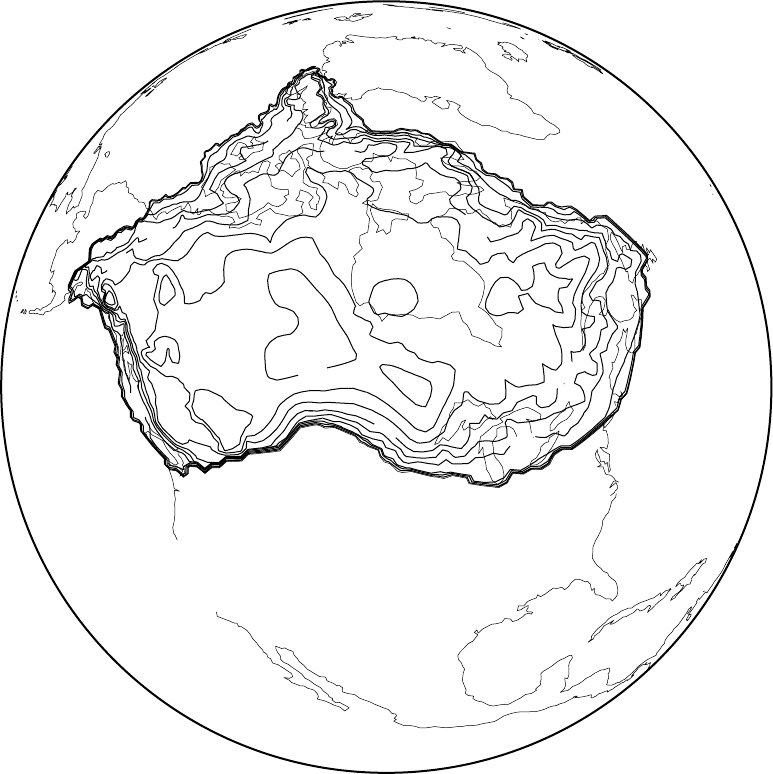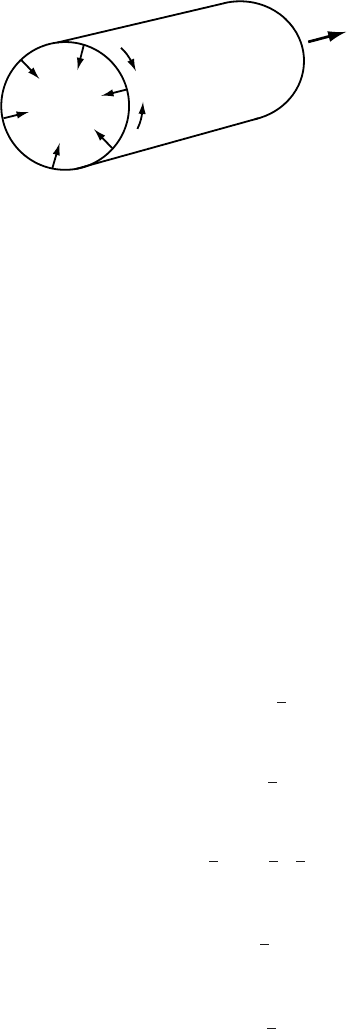Hooke R.L. Principles of glacier mechanics
Подождите немного. Документ загружается.

Examples 311
climate model tuned with ice core records. With an enhancement factor
(Equation (4.10)) of 6 and without basal sliding, the model simulates
the modern Greenland Ice Sheet well, and is in close agreement with
other EISMINT models of Greenland. However, when it is then used
to model the Laurentide Ice Sheet, it produces an LGM ice mass with
avolume of 36.3 × 10
6
km
3
,whereas studies of moraines, LGM sea
level, and post-glacial isostatic recovery suggest that the actual volume
was only ∼22.5 × 10
6
km
3
.Totry to bring the calculated volume into
better agreement with that observed, Marshall et al. first added a calv-
ing routine. With reasonable calving rates, this reduced the volume only
modestly. Higher calving rates led to inconsistencies with the known
ice sheet extent in Hudson Bay and Hudson Strait. They then added a
sliding routine but did not retain the calving algorithm. This reduced
the volume to 29.1 × 10
6
km
3
and resulted in an ice sheet extent
that was in reasonable agreement with observations of glacial geolo-
gists (Figure 11.9). A further reduction in calculated ice volume could
have been achieved by increasing the enhancement factor or by reducing
precipitation in the climate forcing, but these options were not explored
quantitatively.
The enhancement factor that Marshall et al. used for Greenland
probably reflects: (1) development of strong single-maximum crystal
fabrics, and (2) sliding, which occurs in Greenland but is not allowed
in their model. Paterson (1991) has argued that the former is facili-
tated by impurities because impurities inhibit grain-boundary migration,
resulting in smaller crystals, and smaller crystals recrystallize readily,
leading to strong preferred orientations. Pleistocene ice tends to have
more impurities, smaller grain sizes, and higher strain rates. The softness
of Pleistocene ice was apparently first recognized in borehole deforma-
tion studies on Barnes Ice Cap (Hooke, 1973b) and later in similar studies
on Devon (Paterson, 1977) and Agassiz (Fisher and Koerner, 1986) Ice
Caps and then in Greenland (Dahl-Jensen and Gundestrup, 1987). During
the Holocene the basal layers of Pleistocene ice in these four ice masses
have thinned, so they now have less influence on the profile than was
likely to have been the case during the Wisconsinan in the Laurentide Ice
Sheet. Thus, it is reasonable to expect that the appropriate enhancement
factor for the Laurentide Ice Sheet would be higher than that for Green-
land today. Other modelers have also found that relatively high enhance-
ment factors were required to model the accepted volume of the Lau-
rentide Ice Sheet (Huybrechts and T’Siobbel, 1995;Tarasov and Peltier,
1999).
In conclusion, the Laurentide Ice Sheet can be modeled successfully
if algorithms for sliding and calving are included, if Pleistocene ice is

312 Numerical modeling
2000
1600
2000
1600
2000
1200
2000
1800
2600
2000
Contour intervals on ice sheet:
400 m below 1600 m
200 m above 1600 m
Figure 11.9. Surface topography of the Laurentide Ice Sheet at 20 ka
calculated with a thermomechanical model that included a basal sliding routine.
(Modified from Marshall et al., 2000, Figure 9b. Used with permission of the
authors and the Canadian Journal of Earth Sciences.)
assumed to have been softer than Holocene ice, and if the Pleistocene
climate is assumed to have been somewhat drier than the Holocene cli-
mate. Marshall et al.(2000)donot pursue combinations of these effects,
arguing sensibly that the physics of the calving and sliding processes are
not known well enough. Sliding, for example, depends on pore water
pressures in the substrate, and pore water pressures, in turn, depend
Summary 313
upon basal temperatures and the efficiency of the basal drainage system.
Models of the basal drainage system are even more tenuous than those
of calving and, as noted above, basal temperature distributions are not
modeled consistently.
In short, we can choose between viewing the glass as half empty or
half full. We have a long way to go to write calving and sliding algorithms
that are well-supported by physics. On the other hand, the models seem
to have already revealed important characteristics of the Laurentide Ice
Sheet and of ice in it.
Summary
In this chapter we have reviewed the two main numerical modeling tech-
niques commonly used in glaciology: the finite-difference and finite-
element techniques. For simple problems, finite-difference approaches
can be implemented with a spread sheet or simple computer program.
Finite-element approaches and finite-difference solutions of more com-
plex problems both require more sophisticated computer programs.
While numerical details of these advanced techniques are beyond the
scope of this book, we have introduced some of the vocabulary com-
monly associated with them.
Owing to their complexity, numerical models can easily have flaws
that result in realistic but incorrect predictions. Parts of models can often
be tested against analytical solutions before the model as a whole is
applied to problems without such solutions. Output of models of entire
ice sheets can be compared with the EISMINT benchmarks. The lat-
ter tests have shown that models generally do well at predicting the
size and shape of an ice sheet, but relatively subtle differences among
the models result in significant differences in solutions for basal temper-
ature distribution, and in particular in the fraction of the bed that is at
the pressure melting point.
In the last part of the chapter, we explored three applications of
models to problems of glaciological and geomorphological significance.
In the first, a finite-element model was used to study the stress distribution
in a calving face in order to see if a physical explanation could be found
for the commonly cited proportionality between water depth and calving
rate. In the second, another finite-element model predicted that when
an ice sheet advances over permafrost, a frozen margin of appreciable
width is likely to develop and to persist for centuries or millennia. Certain
landforms have been interpreted as being a consequence of such a frozen
margin. Finally, we discussed a finite-difference model of the Laurentide
Ice Sheet and found that with certain reasonable assumptions relatively
314 Numerical modeling
good agreement probably could be obtained between the size calculated
by the model and that determined from moraines, sea level records, and
isostatic rebound. The results point to the need for a better quantitative
understanding of sliding, calving, and the development of basal drainage
systems, and of climate history, while at the same time they constrain
the ranges of these parameters that will yield agreement between model
and probable reality.
Chapter 12
Applications of stress and deformation
principles to classical problems
In this chapter, we will study some glaciologically significant problems
for which an appreciation of the material presented in Chapters 9 and 10
is required. Our objective is not to provide a comprehensive overview of
theoretical developments in glaciology, but rather to solidify the gains
made in these preceding two chapters by applying the principles devel-
oped therein. In the course of this discussion, the student will be intro-
duced to some definitive studies, frequently referenced in the glaciolog-
ical literature.
Let us first consider the problem of closure of a cylindrical borehole,
in part because this is relevant to our earlier discussion of glacier hydrol-
ogy. Then we will investigate efforts to calculate basal shear stresses
using a force balance model, followed by study of the creep of ice shelves.
Finally, the problem of using borehole deformation experiments to obtain
estimates of the values of the parameters in the flow law will round out
the chapter.
Collapse of a cylindrical hole
The first problem we address is that of the closure of a cylindrical hole
in ice. This problem was studied by Nye (1953)inthe context of using
closure rates of tunnels in ice to estimate the constants in Glen’s flow law,
and our development is based on Nye’s paper. More recently, the theory
has been used to analyze two problems in water flow at the base of a
glacier: (1) the closure of a water conduit, and (2) leakage of water into
or away from a subglacial conduit. We used the first of these analyses in
Chapter 8 (Equation (8.3)).
315

316 Applications of stress and deformation principles
s
a
s
qq
z
Figure 12.1. Stresses on the
wall of a cylindrical hole in a
weightless medium.
Our approach is very similar to that used in Chapter 10 to obtain
stresses and velocities in a “glacier” consisting of a slab of ice resting
on a bed with a uniform slope. We first reduce the problem to one of
plane strain by setting it up so that there is no deformation parallel to
the axis of the hole. This reduces the number of unknowns from nine –
the three components of the velocity vector and six components of the
stress tensor – to five. Expressions for the stresses and strain rates are
then obtained and inserted into the momentum and continuity equations.
Finally, we use a constitutive relation between stress and stain rate, Glen’s
flow law, to obtain the desired solution.
Consider, first, the closure of a hole of radius a in an infinite weight-
less medium (Figure 12.1). There is no strain parallel to its axis, the
z-direction. Once the solution to this problem is obtained, we will mod-
ify it to apply to a real glacier. On the surface of the hole, at r = a,an
internal tension, σ
a
,is(somehow) applied. Eventually, this stress will be
equated with that resulting from the difference between the pressure in
the ice and that in the hole.
As there is no deformation in the z-direction, ˙ε
zz
= λσ
zz
= 0. Thus,
σ
zz
= 0 = σ
zz
−
1
3
(
σ
rr
+ σ
θθ
+ σ
zz
)
or
σ
zz
=
1
2
(
σ
rr
+ σ
θθ
)
(12.1)
The mean stress thus becomes
P =
1
3
σ
kk
=
1
3
3
2
(
σ
rr
+ σ
θθ
)
so
σ
rr
=
1
2
(
σ
rr
− σ
θθ
)
(12.2)
and
σ
θθ
=−
1
2
(
σ
rr
− σ
θθ
)
(12.3)
This gives us expressions for the three deviatoric stresses and the mean
stress.

Collapse of a cylindrical hole 317
As stated, there is no deformation in the z-direction and, in addition,
the hole wall cannot support shear tractions. Thus, in view of the radial
symmetry, there can be no shear stresses in the θ - and z-directions in the
medium away from the hole. Therefore, σ
rr
, σ
θθ
, and σ
zz
are principal
stresses. The effective stress is then
σ
2
=
1
2
2
1
4
(
σ
rr
− σ
θθ
)
2
or
σ =
1
2
|
σ
rr
− σ
θθ
|
(12.4)
Let us now obtain another relation between σ
rr
and σ by considering
rdq
s
rr
r
dq
s
qq
dq/2
s
qq
dq/2
dr
s
rr
+
ds
rr
dr
dr
Figure 12.2. Stresses on a
segment of the wall of a
cylindrical hole.
the condition for stress equilibrium. From Figure 12.2,wehave
σ
rr
(rdθ) −
σ
rr
+
dσ
rr
dr
dr
(
r + dr
)
dθ + 2σ
θθ
dr
dθ
2
= 0
Canceling like terms of opposite sign, dividing by dr dθ , and ignoring
the term still containing a differential yields
r
dσ
rr
dr
+ σ
rr
− σ
θθ
= 0
or, by using Equation (12.4)
dσ
rr
dr
+
2σ
r
= 0 (12.5)
At any radius r ≥ a the stress is σ
rr
.Atinfinity σ
rr
= θ . Thus, Equation
(12.5)may be integrated:
0
σ
rr
dσ
rr
=−
∞
r
2σ
r
dr
or
σ
rr
=
∞
r
2σ
r
dr (12.6)
In order to integrate Equation (12.6), we must express r in terms
of σ .Wewill do this by determining the velocity field, and hence ˙ε,
and inserting a flow law. Let u be the velocity in the radial direction.
Other velocities vanish owing to the radial symmetry and the absence
of deformation in the z-direction. Conservation of mass requires that the
mass flux through two concentric cylindrical surfaces with radii r and
r + dr (Figure 12.3) must be the same in an incompressible medium.
Thus, we have
2ur = 2
u +
du
dr
dr
(r + dr)

318 Applications of stress and deformation principles
r
dr
u
u
+
∂u
dr
∂r
Figure 12.3. Radial velocity
field around a cylindrical hole.
which may be simplified, thus:
du
dr
=−
u
r
(12.7)
and integrated to yield
ln u =−ln r + ln c
Because we obtained this without referring to the direction of u,aminus
sign is now inserted to indicate that u is in the negative r-direction.
Thus,
u =−
c
r
So u is directed toward the hole and is a maximum on the hole wall, at
r = a.Itdecreases to 0 at r =∞.
From its definition in terms of velocity derivatives (Equations
(9.21)), we see that ˙ε
rr
= ∂u/∂r, so from Equation (12.7):
˙ε
rr
=−
u
r
and by continuity, since ˙ε
zz
= 0,
˙ε
θθ
=−˙ε
rr
=
u
r
The effective strain rate is thus:
˙ε
2
=
1
2
˙ε
ij
˙ε
ij
=
1
2
2
u
2
r
2
As u =−c/r, this becomes:
˙ε =
c
r
2
(12.8)
We can retain the generality of the solution a little longer before
inserting a flow law. Because ˙ε = f (σ ), we have
f (σ ) =
c
r
2
(12.9)

Collapse of a cylindrical hole 319
To obtain r in terms of σ , note that (using Equation (12.9)):
df(σ )
dσ
=
df(σ )
dr
dr
dσ
=−
2c
r
3
dr
dσ
Again using Equation (12.9)toeliminate c:
df(σ )
dσ
=−
2
r
f (σ )
dr
dσ
so:
dr =−
r
2
df(σ )
f (σ )
Substituting this into Equation (12.6) yields
σ
rr
=−
2σ
r
r
2
df(σ )
f (σ )
=−
σ
f (σ )
df(σ ) (12.10)
It is now necessary to make use of a flow law, specifically Glen’s
flow law, to obtain an analytical expression for the functional relation in
Equation (12.9), thus:
˙ε = f (σ ) =
σ
B
n
=
c
r
2
(12.11)
whence, differentiating:
df(σ ) =
nσ
n−1
B
n
dσ
With the use of these last two relations, Equation (12.10) becomes
σ
rr
=
σ
0
σ
(
σ/B
)
n
nσ
n−1
B
n
dσ =
σ
0
ndσ
so,
σ
rr
= nσ (12.12)
In other words, the radial stress at any distance r ≥a from the hole wall is
simply n times the effective stress. One cannot help but be impressed by
the simplicity and elegance of this result, considering the effort required
to obtain it. Unfortunately, real life is rarely so conveniently uncom-
plicated. Furthermore, we still have some way to go before obtaining
relations that can be applied to real glaciers.
In preparation for relaxing the assumption that the medium is weight-
less, let us now scale this solution to the normal stress, σ
a
,onthe hole
wall. Using the last equality in Equation (12.11)toobtain an expression
for σ , σ
rr
and σ
a
become:
σ
rr
= nB
c
r
2
1/n
and σ
a
= nB
c
a
2
1/n
whence:
σ
rr
σ
a
=
a
r
2/n
(12.13)

320 Applications of stress and deformation principles
Solutions for the remaining stresses can now be written similarly, as
follows. From Equations (12.4) and (12.12):
σ =
1
2
(
σ
rr
− σ
θθ
)
=
1
2
(
nσ − σ
θθ
)
whence, transposing and again using the last equality in Equation
(12.11):
σ
θθ
=
(
n − 2
)
σ =
(
n − 2
)
B
c
r
2
1/n
so:
σ
θθ
σ
a
=
n − 2
n
a
r
2/n
(12.14a)
Then, from Equations (12.1), (12.13), and (12.14a):
σ
zz
σ
a
=
1
2
σ
rr
σ
a
+
σ
θθ
σ
a
=
1
2
a
r
2/n
+
n − 2
n
a
r
2/n
=
1
2
a
r
2/n
1 +
n − 2
n
so
σ
zz
σ
a
=
n − 1
n
a
r
2/n
(12.15)
Finally, from Equations (12.4 ), (12.13), and (12.14a):
σ
σ
a
=
1
2
σ
rr
σ
a
−
σ
θθ
σ
a
=
1
2
a
r
2/n
−
n − 2
n
a
r
2/n
Thus,
σ
σ
a
=
1
n
a
r
2/n
(12.16)
We can now relax the assumption that the medium is weightless.
Suppose we have a horizontal hole at atmospheric pressure at a depth
h
o
in a real glacier. The hydrostatic pressure in the glacier is P = ρgh,
and around the hole it is P = ρgh
o
. Note that P is not equal to the
mean stress, P(=
1
3
σ
kk
). If h
o
a, P will be nearly uniform around the
hole. We have not previously specified the magnitude of σ
a
,solet us
now solve Equations (12.13) through (12.16) for σ
ii
(i = r, θ, z) with
σ
a
= P. Furthermore, because P is hydrostatic, let us add a compres-
sive stress, −P,tothe solutions. This is valid because a hydrostatic
pressure influences all of the stresses equally, and therefore does not
affect the local differences among the stresses given by Equations (12.13)
